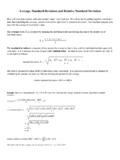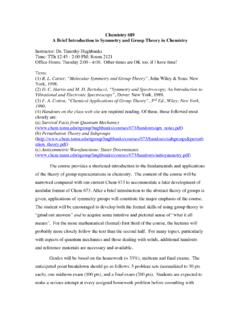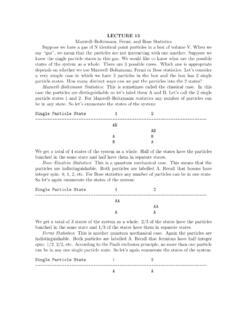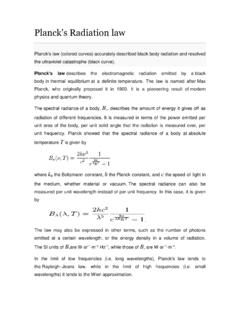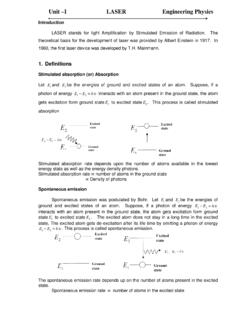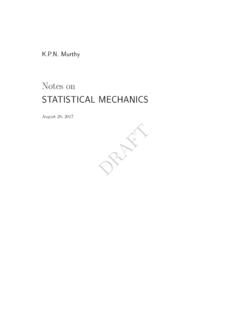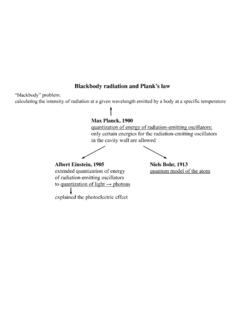Transcription of Chapter 15. Statistical Thermodynamics
1 boltzmann distribution Partition Functions Molecular Energies The Canonical Ensemble Internal energy and entropy Derived functionsChapter 15. Statistical ThermodynamicsMajor ConceptsReviewDiscrete Energy levelsParticle in a boxRigid rotorHarmonic OscillatorMathProbability Lagrange MultipliersProperties of lnMicroscopic PropertiesQuantum MechanicsSpectroscopyVibrational frequenciesBond dissociationsMacroscopic PropertiesThermodynamicsHeat capacityCoefficient of expansionStatistical MechanicsStatistical ThermodynamicsStatistical Thermodynamics provides the link between the microscopic ( , molecular) properties of matter and its macroscopic ( , bulk) properties. It provides a means of calculating thermodynamic properties from the Statistical relationship between temperature and on the concept that all macroscopic systems consist of a large number of statesof differing energies, and that the numbers of atoms or molecules that populate each of these states are a function of the thermodynamic temperature of the of the first applications of this concept was the development of the kinetic theory of gases and the resulting maxwell - boltzmann distribution of molecular velocities, which was first developed by maxwell in 1860 on purely heuristic grounds and was based on the assumption that gas molecules in a system at thermal equilibrium had a range of velocities and, hence.
2 Performed a detailed analysis of this distribution in the 1870 s and put it on a firm Statistical foundation. He eventually extended the concept of a Statistical basis for all thermodynamic properties to all macroscopic systems. 223/ 23/ 2vMv2222v4v4v22mkTRTmMfeekTRT maxwell - boltzmann distribution : Statistical ThermodynamicsStatistics and EntropyMacroscopic state:-state of a system is established by specifying its T, E ,S ..Microscopic state:-state of a system is established by specifying x, p, .. of than one microstate can lead to the same : 2 particles with total E = 2 Can be achieved by microstates 1, 1 or 2, 0 or 0, 2 Configuration:-The equivalent ways to achieve a stateW (weight):-The # of configurations comprising a stateProbability of a state:-# configuration in state / total # of configurations(Assumes that the five molecules are distinguishable.)
3 Weight of a Configuration012301230123!!!!!!lnln!!!!l n! ln!!!!ln!ln!iiNWN N N NNWN N N NNN N N NNN Using Sterling s Approximation: ln N! ~ N ln N N, which is valid for N 1,lnlnlniiiWNNNN Global maximum in f when df= 0 df f x ydx f y xdy Seek a maximum in f(x,y) subject to a constraint defined by g(x,y) = 0 Since g(x,y) is constant dg = 0 and: dg g x ydx g y xdy 0 This defines dx g y g x dyanddy g x g y dx Eliminating dx or dyfrom the equation for df:df f y f x g y g x dy 0ordf f x f y g x g y dx 0 Defines undetermined multiplier f y g yor f x g x f x g x 0or xf g 0 f y g y 0 yf g 0orSame as getting unconstrainedmaximum of K f g Undetermined Multipliers (Chemist s Toolkit )Example of Undetermined MultipliersA rectangular area is to be enclosed by a fence having a total length of 16 meters, where one side of the rectangle does not need fence because it is adjacent to a river.
4 What are the dimensions of the fence that will enclose the largest possible area?riveryxxThus, the principal (area) function is:F(x,y) = xy(1)and the constraint (16 meters) is: f(x,y) = 2x + y 16 = 0(2)If F(x,y) were not constrained, , if xand ywere independent, then the derivative (slope) of Fwould be zero:(3)and(4)However, this provides only two equations to be solved for the variables xand y, whereas three equations must be satisfied, viz., Eqs. (4) and the constraint equation f(x,y) = (,) 00and0 FFxy Example of Undetermined MultipliersThe method of undetermined multipliers involves multiplying the constraint equation by another quantity, , whose value can be chosen to make xand yappear to beindependent. This results in a third variable being introduced into the three-equation problem.
5 Because f(x,y) = 0, maximizing the new function F F (x,y) F(x,y) + f(x,y)(5)is equivalent to the original problem, except that now there are three variables, x, y, and , to satisfy three equations:(6)Thus Eq. 5 becomesF (x,y) = xy+ (2x + y -16)(7)Applying Eqs. (6),yielding = 4, which results in x= 4 and y= 8. Hence, the maximum area possible is A = 32 m2.''00and( , ) 0 FFf x yxy '202 Fyyx '0 Fxxy 2162216 0xy Find a maximum of fx,y e x2 y2 Subject to the constraint gx,y x 4y 17 0 From slope formula df f x ydx f y xdy 0df 2xe x2 y2 dx 2ye x2 y2 dy 0 Global maximum: x = y = 0 Need to find constrainedmaximum Find undetermined multiplierK(x,y) f(x,y) g(x,y) e x2 y2 x 4y 17 An unconstrained maximum in K must K x 2xe x2 y2 0 K y 2ye x2 y2 4 0 2xf y2f This implies 2x y24x y Original condition g = 0gx,y x 44x 17 0 Constrained maximum : x = 1; y = 4 Example of Undetermined MultipliersMost Probable distribution = = !
6 1! 2! 3!..Configurations:(permutations)Total energy:Maximum probability (and, hence, maximum entropy) occurs when each particle is in a different energy minimum energy occurs when all particles are in the lowest energy level. Thus, must find the maximum probability that is possible, consistent with a given total energy, E, and a given total number of particles, is an example of a classic problem, in which one must determine the extrema ( , maxima and/or minima) of a function, , that are consistent with constraints that may be imposed because of other functions, , energy and number of particles. This problem is typically solved by using the so-called LaGrange Method of Undetermined : N = 20,000; E = 10,000; three energy levels 1=0, 2=1, 3= E requires that N2+ 2N3= 10,000; constant N requires that N1+ N2+ N3= 20,0000 < N3 < 3333; W is maximum when N3~1300.
7 = Total number of particles:The most probable distribution is the one with greatest weight, W. Thus, must maximize lnW. Because there are two constraints (constant E and constant N), must use two undetermined multipliers: g(xi) = 0 and h(xi) = 0 so K = (f + ag +bh) Use this to approach to find most probable population:K lnW aN Njj bE Nj jj (constant N) (constant E)Want constrained maximum of lnW(equivalent to unconstrained maximum of K) Use Stirling'sApproximation for lnW:K NlnN NjlnNjj aN Njj bE Nj jj Can solve for any single population Ni(all others 0): N Ni 0 Ni Ni 1 Nj Ni 0 K Ni lnNi Ni 1Ni a 1 b i 0 K Ni lnNi 1 a b i 0lnNi 1 a b iMost Probable DistributionN Njj Ae b jj A Ne b jj Ni Ne b ie b jj b 1kbTpi NiN e ikbTe jkbTj A exp 1 a Ni Ae b iIf , then A (a) can be eliminated by introducing N.
8 boltzmann Temperature (will prove later) boltzmann DistributionBoltzmann DistributionlnNi 1 a b i =e =e For relative populations:Gives populations of states, not more than one state at same energy, must account for degeneracy of state, gi. = e Most Probable DistributionIn summary, the populations in the configuration of greatest weight, subject to the constraints of fixed E and N, depend on the energy of the state, according to the boltzmann distribution : iikTikTiNeNe The denominator of this expression is denoted by qand is called the partition function, a concept that is absolutely central to the Statistical interpretation of thermodynamic properties which is being developed can be seen in the above equation, because kis a constant ( boltzmann s Constant), the thermodynamic temperature, T, is the unique factor that determines the most probable populations of the states of a system that is at thermal Probable DistributionIf comparing the relative populations of only two states, iand j, for example,iijjkTikTjkTNeeNe The boltzmann distribution gives the relative populations of states, notenergy levels.
9 More than one state might have the same energy, and the population of each state is given by the boltzmann distribution . If the relative populations of energy levels, rather than states, is to be determined, then this energy degeneracy must be taken into account. For example, if the level of energy iis gi-fold degenerate ( , gistates have that energy), and the level of energy jis gj-fold degenerate, then the relative total populations of these two levels is given by:iijjkTiiikTjjkTjNg egeNgge Example Partition Function: Uniform Ladder =1+e +e 2 +e 3 + =1+e +e 2+e 3+ 11 =1+ + 2+ 3+ =11 e Example Partition Function: Uniform LadderBecause the partition function for the uniform ladder of energy levels is given by:then the boltzmann distribution for the populations in this system is:Fig.
10 Shows schematically how pivaries with temperature. At very low T, where q 1, only the lowest state is significantly populated. As T increases, higher states become more highly populated. Thus, the numerical value of the partition function gives an indication of the range of populated states at a given b (1)(1)iiiikTkTiNepeeeeNq b b b Two-Level SystemFor a two-level system, the partition function and corresponding population distribution are given by:and11kTqee b 11iiikTikTeeepqee b b b Two-Level SystemIn this case, because there are only two levels and, hence, only two populations, p0and p1, and because 0= 0 and 1= 1, thenandAt T = 0 K, q= 1, indicating that only one state is occupied. With increasing temperature, qapproaches , at which point both states are equally populated.

